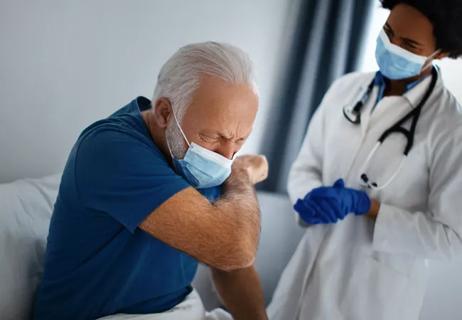New legislation expands care for veterans exposed to burn pits, and Cleveland Clinic has developed a dedicated protocol to better treat deployers experiencing lung disease

Image courtesy of Jeff Stein
Cleveland Clinic is a non-profit academic medical center. Advertising on our site helps support our mission. We do not endorse non-Cleveland Clinic products or services. Policy
Written by Neha Solanki, MD, Jeff Stein and Maeve G. MacMurdo, MBChB
An estimated 3.5 million U.S. veterans have been exposed to contaminants and
hazardous pollutants while deployed.1 While abroad, service members can be exposed
to a variety of environmental pollutants, which include exhaust from military vehicles
and particulate matter from deserts and unregulated industry.2 Other adverse environmental exposures include aeroallergens and massive sandstorms with sharp particulate matter comprising of metals and aerosolized metals from improvised explosive devices (IEDs).3
Another type of pollutant that can penetrate deeply into the lung and impair function is fine particulate matter (PM) or fine particles. These are classified by their diameter, so PM2.5 refers to tiny particles that are 2.5 micrometers or less in width. Studies have shown that levels of PM2.5 exceeded both U.S. Environmental Protection Agency and U.S. National Ambient Air Quality Standards at multiple bases across the Middle East.3,4 Exposure to PM2.5 has been associated with an increased risk of cardiovascular disease, worsening asthma control and a range of other negative health outcomes — increasingly, the potential for scarring of the lungs (pulmonary fibrosis) associated with chronic high-level exposure to PM2.5 is also recognized.5-7
A major, and previously unrecognized, source of exposure faced by veterans is burn pits, which contain large quantities of PM2.5 and other hazardous pollutants. Burn pits are open-air waste disposal sites that were utilized on many bases throughout Iraq, Afghanistan and other areas of the Southwest Asia theater of military operations to dispose of human waste, refuse and medical supplies. To quote one deployer: “I lived on small patrol bases while forward deployed to Afghanistan. Each patrol base had its own burn pit, and though efforts were made to place the burn away from the personnel, we inevitably were exposed to the noxious fumes. This occurred on a daily basis: whenever we were disposing of waste; whether feces or other trash items, we had to go into the smoke.”
A range of lung diseases have been associated with deployment-related exposures. Studies have shown a high rate of new-onset asthma and vocal cord dysfunction following deployment.3 Rare lung disease has also been reported, including multiple cases of constrictive bronchiolitis — an interstitial lung disease characterized by progressive, irreversible destruction of the lung parenchyma.8 Because of the range and variety of exposures faced by deployers, identifying a specific exposure associated with these lung diseases has been challenging.
Recognizing these challenges, the Sergeant First Class Heath Robinson Honoring our Promise to Address Comprehensive Toxics (PACT) Act significantly expands the list of pulmonary diseases that are now considered “presumptive” by the U.S. Department of Veterans Affairs (VA) (Table 1). The PACT Act reduces the burden of proof for deployers with lung disease potentially related to burn pit exposure and enhances (VA) healthcare eligibility for toxin-exposed veterans. This bipartisan bill is the most significant expansion of veterans’ healthcare and benefits in over 30 years.
The Respiratory Institute has developed a dedicated protocol for evaluation of deployment-related lung disease. Deployers and veterans may undergo a range of testing by a multidisciplinary team depending on their symptoms, deployment history and prior evaluation, including dedicated chest imaging, evaluation for inducible laryngeal obstruction, and both traditional and invasive-cardiopulmonary exercise testing. Jeff Stein, the nurse coordinator of this initiative, previously served in the U.S. Marine Corps.
He says: “My advice to my fellow brothers and sisters who were exposed to these fumes and are currently experiencing respiratory problems is to seek help. You can consult your PCP or your local VA and have them get you referred to a respiratory specialist. The main concern is to get better in order to live the best life possible. We have served our country. We should seek care that heals our ailments and gets us back in the fight.”
References

A review of IDSA and NIH guidelines

Caregivers are provided with real-time bronchoscopy patient findings

New program sets out to better support underserved patient populations

As the U.S. has seen an increase in respiratory-related morbidity and mortality, supporting future respiratory researchers has become imperative

Diagnosing the cause of a chronic cough can be challenging and timely, but multidisciplinary collaboration and the development of new treatments are improving the process

Despite a decline in numbers, the demand for respiratory therapists continues to rise

A mindset shift has changed the way pulmonologists both treat and define PFF

Will enable patients with long COVID to enroll in national clinical trials